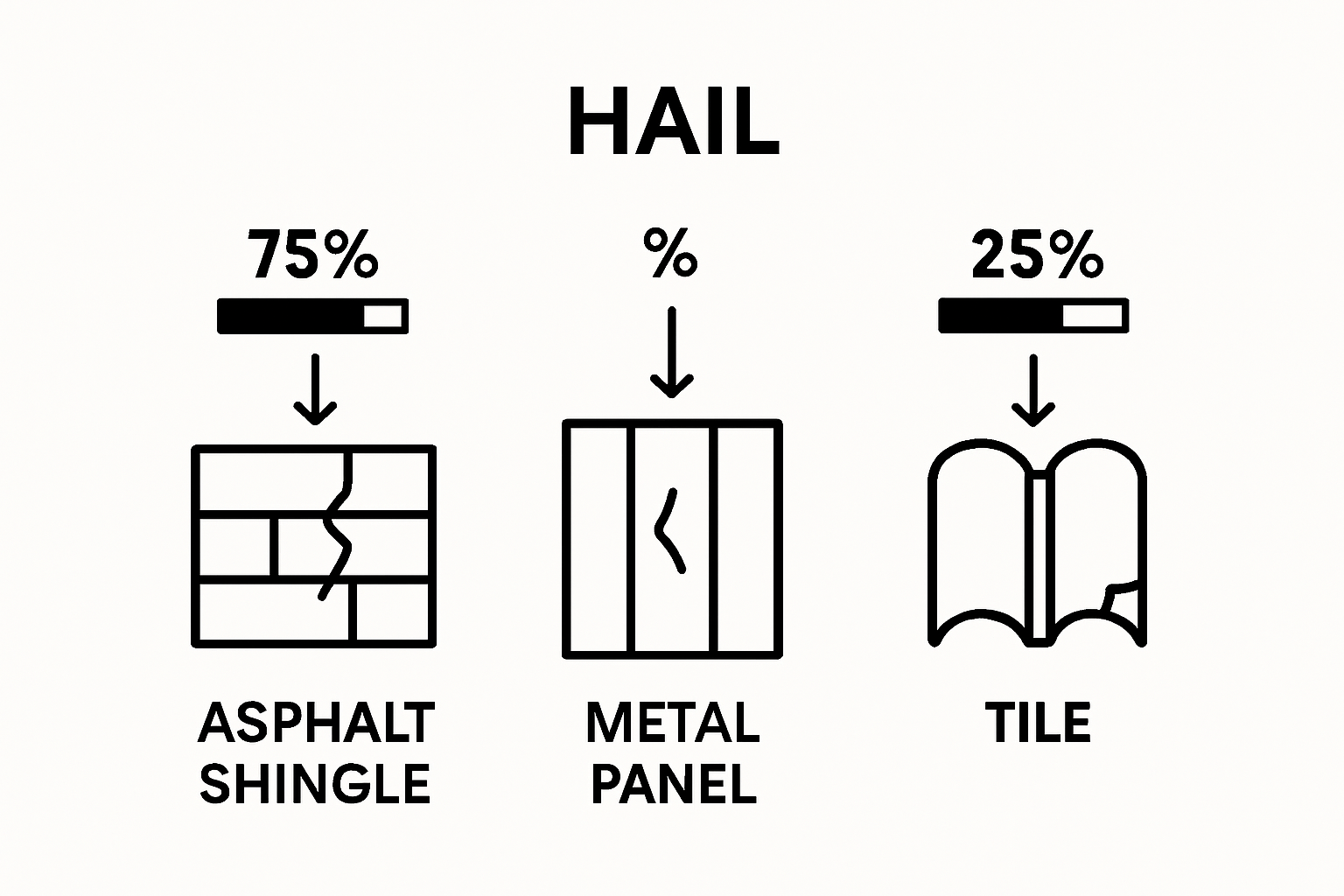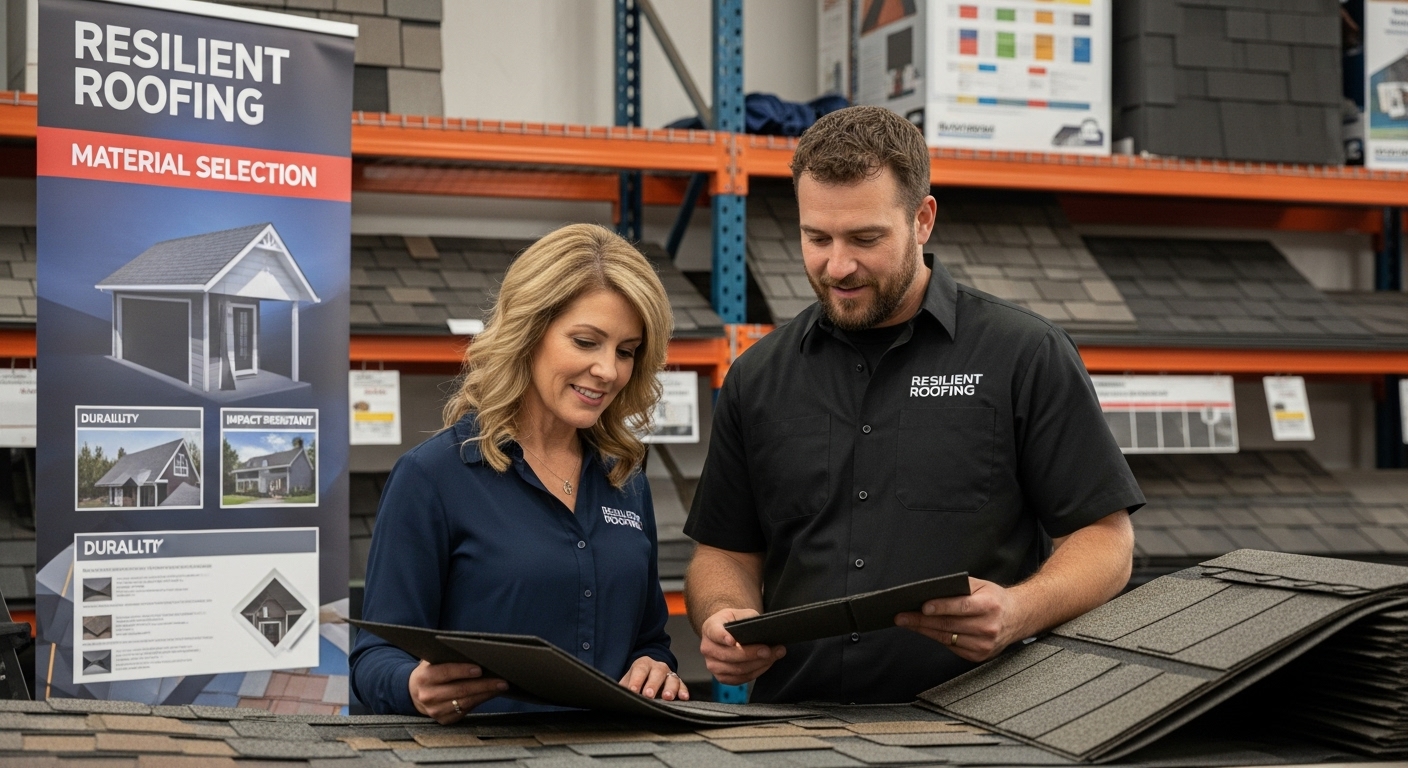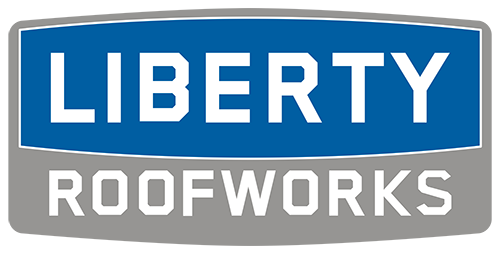Hail might look harmless as it bounces off cars and lawns, but your roof tells a different story. Every year, hailstorms cause billions of dollars in property damage across the United States, quietly battering homes in ways most people never realize. The real shock is that even a one-inch hailstone can compromise a roof’s strength, setting off costly problems you might not notice until it is too late.
Table of Contents
- What Is Roof Hail Damage And How Does It Occur?
- The Importance Of Recognizing Roof Hail Damage
- How Hail Impacts Different Roof Materials
- Identifying The Signs Of Hail Damage On Your Roof
- Preventive Measures And Long-Term Considerations
Quick Summary
| Takeaway | Explanation |
|---|---|
| Promptly inspect roofs after hailstorms | Immediate assessments help identify early signs of damage to prevent costly repairs later. |
| Hail damage may be subtle and hidden | Damage can create microscopic fractures that compromise roof integrity, often unnoticed without a professional check. |
| Choose impact-resistant roofing materials | Selecting durable materials can significantly reduce the risk of hail damage and extend roof lifespan. |
| Document roof condition regularly | Keeping a record of inspections and repairs aids in insurance claims and maintenance planning. |
| Professional inspections are crucial | Experts can detect nuanced indicators of damage that homeowners may miss, ensuring comprehensive assessments. |
What Is Roof Hail Damage and How Does It Occur?
Roof hail damage represents a significant threat to residential and commercial roofing systems, causing potentially extensive and costly structural deterioration. Understanding what constitutes roof hail damage involves recognizing the complex interaction between falling ice pellets and various roofing materials.
The Physics of Hail Impact
Hail forms when water droplets are carried upward by powerful thunderstorm updrafts into extremely cold atmospheric regions, freezing and accumulating layers of ice. When these ice formations become too heavy, they fall to the ground at velocities ranging from 20 to 100 miles per hour. The kinetic energy of hailstones determines the severity of roof damage, with larger and denser hailstones causing more significant destruction.
According to National Oceanic and Atmospheric Administration, hailstorms cause billions of dollars in property damage annually across the United States. The impact varies depending on multiple factors:
- Size of hailstones (ranging from pea-sized to softball-sized)
- Wind speed and direction
- Angle of hail impact
- Roofing material composition
Manifestations of Hail Damage
Roof hail damage manifests differently across various roofing materials. Asphalt shingles might show bruising or granule loss, while metal roofs could display dents and punctures. The damage is not always immediately visible, which makes professional storm damage assessment crucial.
Hailstones create microscopic fractures and weaken roofing materials, compromising their protective capabilities. These subtle damages accelerate roof deterioration, potentially leading to leaks, reduced insulation effectiveness, and structural vulnerabilities if left unaddressed. Homeowners and property managers should conduct thorough inspections following significant hailstorms to identify and mitigate potential long-term roofing complications.
The Importance of Recognizing Roof Hail Damage
Recognizing roof hail damage is a critical aspect of home and property maintenance that can save homeowners significant financial and structural complications. Unlike other forms of roof damage, hail impact creates subtle yet potentially devastating consequences that may not be immediately apparent.
Financial Implications of Delayed Detection
Delaying hail damage identification can transform a minor repair into a major renovation expense. Insurance claims typically have specific timeframes for reporting damage, and missing these windows can result in substantial out-of-pocket costs. Research from the Insurance Institute suggests that hail damage claims represent a significant portion of annual property insurance payouts, underscoring the economic importance of prompt damage assessment.
Key financial risks associated with delayed hail damage recognition include:
This table outlines key financial and structural risks associated with delaying hail damage detection, illustrating the consequences described in the article.
| Risk Type | Short-Term Consequences | Long-Term Consequences |
|---|---|---|
| Financial | Increased repair costs | Full roof replacement, lower property value |
| Insurance | Missed claim filing windows | Out-of-pocket expenses, denied claims |
| Structural Integrity | Subtle roof deterioration | Leaks, insulation breakdown, major damage |
| Warranty | Voided manufacturer warranties | Loss of replacement/repair coverage |
- Exponential repair cost increases over time
- Potential complete roof replacement
- Reduced property value
- Voided manufacturer warranties
- Compromised structural integrity
Structural Integrity and Long Term Protection
Hail damage weakens roofing materials at a microscopic level, creating vulnerabilities that compromise the entire roofing system. These invisible fractures accelerate material degradation, leading to potential water infiltration, insulation breakdown, and increased energy inefficiency. Homeowners can learn more about potential roof damage signs to proactively manage their property’s protective envelope.
Professional roof inspections following significant hailstorms are not merely recommended but essential. Trained experts can identify nuanced damage indicators that untrained eyes might miss, providing comprehensive assessments that protect both the immediate structural integrity and long-term performance of residential and commercial roofing systems.
How Hail Impacts Different Roof Materials
Roof materials respond differently to hailstone impacts, with each type experiencing unique damage patterns and vulnerability levels. Understanding these variations is crucial for homeowners seeking comprehensive roof protection and maintenance strategies.
Asphalt Shingle Vulnerability
Asphalt shingles, the most common roofing material in residential construction, are particularly susceptible to hail damage. These shingles contain protective granules that shield the underlying bitumen layer from ultraviolet radiation and environmental stress. During hailstorms, impact energy can dislodge these protective granules, creating several potential damage scenarios:
- Immediate granule loss exposing base material
- Hairline fractures in the shingle substrate
- Accelerated material degradation
- Reduced waterproofing capabilities
According to ASTM International research, hailstones as small as 1 inch in diameter can cause significant structural compromises in standard asphalt roofing systems.
Metal and Tile Roofing Responses
Metal and tile roofing materials demonstrate different hail damage characteristics compared to asphalt. What is Metal Roofing? Understanding these nuances helps homeowners make informed decisions. Metal roofs typically exhibit denting or cosmetic damage without compromising structural integrity, while clay or concrete tiles may crack or chip under substantial hailstone impacts.
The damage potential depends on multiple factors including hailstone size, wind velocity, and material composition.
Below is a comparison table showing how different roofing materials respond to hail impacts, summarizing damage manifestations and vulnerability levels discussed in the article.
| Roofing Material | Typical Hail Damage Observed | Vulnerability to Hail | Damage Characteristics |
|---|---|---|---|
| Asphalt Shingles | Granule loss, bruising, fractures | High | Exposed base material, reduced lifespan |
| Metal Roofing | Dents, minor punctures | Moderate | Mostly cosmetic, rarely structural |
| Tile Roofing (Clay/Concrete) | Cracks, chips, breakage | Moderate to High | Potential for tile breakage and leaks |
| Polymer-Modified Systems | Minor surface marks, rare cracks | Low | Enhanced impact resistance |
 Professional roof inspections remain the most reliable method for accurately assessing hail-related deterioration across different roofing systems, ensuring timely interventions that prevent long-term structural complications.
Professional roof inspections remain the most reliable method for accurately assessing hail-related deterioration across different roofing systems, ensuring timely interventions that prevent long-term structural complications.
Identifying the Signs of Hail Damage on Your Roof
Recognizing hail damage requires a keen eye and understanding of subtle indicators that might escape untrained observation. Homeowners must develop a comprehensive approach to damage assessment that goes beyond surface-level visual inspections.
Visual Inspection Techniques
Hail damage manifests through distinctive patterns and characteristics across different roofing materials. Systematic visual examination becomes crucial in identifying potential vulnerabilities. Homeowners should look for specific telltale signs that indicate hailstone impact:
- Random and scattered damage patterns
- Dark spots or bruising on shingle surfaces
- Exposed substrate material
- Granule accumulation in gutters
- Unexpected soft spots when walking on the roof
According to Insurance Institute for Business & Home Safety, authentic hail damage occurs in unpredictable distributions, distinguishing it from other forms of roof deterioration.
Beyond the Roof Surface
Effective hail damage assessment extends beyond the roof itself. Learn more about storm damage signs to understand comprehensive evaluation techniques. Collateral damage on surrounding property provides crucial context for understanding hailstone impact severity. Homeowners should examine:
- Dents on metal air conditioning units
- Damaged window screens
- Marks on exterior paint
- Damaged siding or trim
These peripheral indicators offer valuable insights into the potential extent of roof damage, helping homeowners make informed decisions about necessary inspections and potential repairs.
Preventive Measures and Long-Term Considerations
Mitigating hail damage requires a proactive approach that combines strategic planning, material selection, and ongoing maintenance. Homeowners must develop comprehensive strategies that protect their roofing investment and minimize potential long-term structural vulnerabilities.
Material Selection and Resilience
Impact-resistant roofing materials represent the first line of defense against hail damage. Modern roofing technologies offer enhanced durability and protection, with certain materials demonstrating superior resistance to hailstone impacts. Homeowners should consider:

- Class 4 impact-rated shingles
- Metal roofing with high dent resistance
- Rubberized or polymer-modified roofing systems
- Specialized coating technologies
According to University of Florida’s IFAS Extension, selecting appropriate roofing materials can significantly reduce long-term maintenance costs and extend overall roof lifespan.
Routine Maintenance and Professional Assessments
Consistent monitoring and professional inspections form the cornerstone of effective hail damage prevention. Learn more about preventative roofing maintenance to develop a comprehensive approach. Homeowners should establish a systematic evaluation process that includes:
- Annual professional roof inspections
- Post-storm comprehensive assessments
- Immediate repair of minor damages
- Documentation of roof condition and maintenance history
These strategic interventions not only protect the structural integrity of the roof but also preserve property value and optimize insurance claim potential in the event of significant hail damage.
Take Action Against Hidden Roof Hail Damage Now
Learning about roof hail damage means realizing how quickly your peace of mind can be disrupted after a storm. You have just seen how hailstones can leave barely visible damage that threatens the structure and longevity of your roof. Knowing that hidden fractures and granule loss are so easy to miss can make anyone feel uneasy about the next heavy rain or wind. If you do nothing, those small issues can grow into expensive repairs or even require a brand new roof. Instead of waiting for leaks or finding out the hard way that your roof is compromised, protect your home or business before the next storm hits.
Let Liberty Roofworks help you stop hail-related problems before they create expensive headaches. Our experts perform thorough storm damage assessment and specialize in residential roof repair & replacements, as well as preventative maintenance for all roofing types. Do not risk bigger repairs tomorrow. Get a professional inspection done right now by visiting Liberty Roofworks and make sure your roof is safe and strong for years to come.
Frequently Asked Questions
What is roof hail damage?
Roof hail damage refers to the physical harm caused to roofing materials due to the impact of hailstones. This can result in granule loss, dents, bruising, and microscopic fractures that compromise the roof’s integrity.
How can I identify hail damage on my roof?
Hail damage can be identified through a visual inspection, looking for signs such as dark spots or bruising on shingles, granule buildup in gutters, and scattered damage patterns. It is essential to be thorough, as some damage may be subtle.
What are the financial implications of ignoring hail damage?
Ignoring hail damage can lead to increasingly expensive repairs over time, potentially resulting in the need for a complete roof replacement, reduced property value, and even issues with insurance claims if damage is not reported within specified timeframes.
Which roofing materials are most vulnerable to hail damage?
Asphalt shingles are particularly susceptible to hail damage, often showing granule loss and fractures. Metal roofs usually exhibit denting, while tile roofs may crack or chip. Each material has differing levels of vulnerability, making it important to choose durable options for hail-prone areas.
